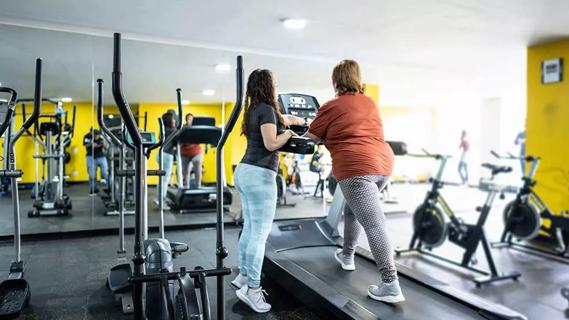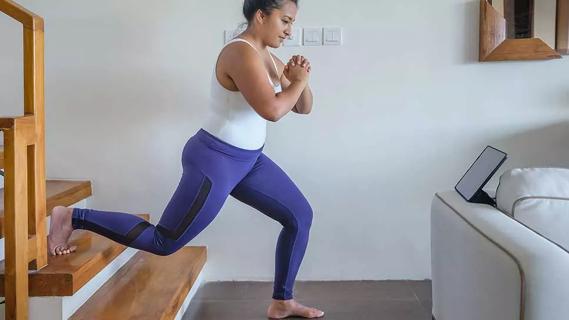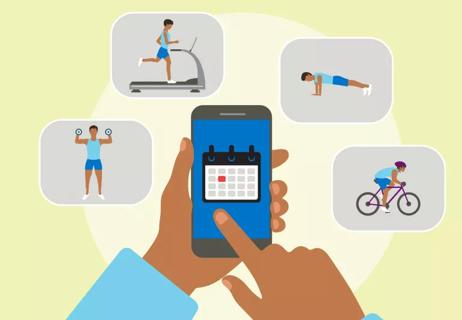Following five critical rules daily for 75 days may not be sustainable

Never give up. Never surrender. You can do anything if you just put your mind to it.
Advertisement
Cleveland Clinic is a non-profit academic medical center. Advertising on our site helps support our mission. We do not endorse non-Cleveland Clinic products or services. Policy
We often rely on mantras like these as a form of motivation. When faced with difficult challenges, we hold on to these ideologies in an effort to push ourselves beyond our current limitations. The goal? To strive for improvement and feel confident in our strengths as we push beyond our comfort zones.
When it comes to physical fitness and our overall well-being, affirmations like these can help when we’re attempting to tackle a new workout routine or a brand-new diet plan or even trying to do small everyday things.
But do we ever run the risk of pushing ourselves too far? And how do we know we’re actually doing enough? Should we, perhaps, in an effort to take better care of ourselves, know when to rest instead of charging forward?
A viral trend known as the 75 Hard Challenge has turned many of these questions on their heads by inspiring people to take part in a strict 75-day lifestyle program. For 75 days, participants must complete five critical daily tasks that double down on exercising twice a day, sticking to a rigid nutrition plan and strengthening your mental fortitude — all without rest, cheat days or substitutions. If even one task is overlooked or left partially completed, the clock restarts, and you’re forced to begin the 75-day program all over again starting with Day One.
Advertisement
Can a rigid program like this be healthy? Or could it actually cause more harm in the long run? Health and sports/performance psychologist Matthew Sacco, PhD, shares why the 75 Hard Challenge raises far more concerns than rewards for most people and how certain aspects of the program can actually be put to good use regardless of the state of your physical, mental and emotional health.
The 75 Hard Challenge was started in 2019 by Andy Frisella, podcaster, entrepreneur and CEO of the supplement company 1st Phorm. One part-fitness program, one-part-nutritional plan, the 75 Hard Challenge centers around the idea of “mental toughness”: That you have to push past your comfort zone and challenge yourself to the extreme in the effort to make long-term lasting improvement on your mind, body and overall outlook on life.
“This is another one of those fad lifestyle plans,” states Dr. Sacco. “On the surface, it’s very much about your willpower and your ability to push yourself and stick to something very rigidly.”
For anyone who has a tough time sticking to new routines and lifestyle changes (like eating healthier or exercising five days a week), change can be difficult. But the 75 Hard mentality has one overarching golden rule designed to get you to avoid cheat meals and quitting on your goals: You must participate and complete every aspect of the five-rule challenge every single day for 75 days; if you fail to deliver, you start all over, and attempt another shot at completing each daily task for another 75 days.
Although Frisella and 75 Hard fanatics swear by their own personal experiences that the program is life-changing, much of its promise is anecdotal. There’s little-to-no scientific evidence the program itself is beneficial, says Dr. Sacco, even when individual parts of the program stem from healthy ideas about forming healthy habits.
“To my knowledge, there’s no science behind it and no research behind it because it’s really kind of anecdotal,” he says. “These very rigid rules become problematic because they boil down this idea that any single person should simply be able to make these choices day-in and day-out without understanding the more interconnected parts to it.”
The 75 Hard Challenge is designed to push you to improve in the areas of physical fitness, emotional resilience and mental insight — all within the context that you should press on when faced with indecision, pain or discomfort.
“It speaks to this idea that we’re supposed to be able to suck it up, pull ourselves up by our bootstraps and move on,” explains Dr. Sacco. “But that’s not a good long-term philosophy, especially if you have chronic, ongoing medical issues.”
The program’s five critical tasks, or core values, are meant to be completed daily for 75 days. And each of the following areas have varying benefits and risks associated with them:
Advertisement
On the 75 Hard Challenge, you can start any diet or nutritional plan, but you’re expected to stick to that plan firmly for 75 days. That means, you can try any healthy or trendy diet or eating style, including:
Advertisement
Whichever plan you choose, you have to stick to it. There’s no room for error and it’s frowned upon to just one day decide you’re going to eat outside of the nutritional box you’ve put yourself in. That means you can’t have a cheat meal along the way or have any alcohol — not for nutritional reasons, but in the effort to drill down on discipline.
If you break away from your nutritional plan of choice, you have to start over. And that can be hard for anyone trying a diet for the first time or anyone with certain dietary restrictions.
“This can be very challenging for people because in our society, food is a very emotional thing, and sometimes, it’s hard to make abrupt changes and make sure you have everything you need and know how to pull it all together even once you’ve settled on a plan,” recognizes Dr. Sacco.
Still, focusing on nutritional value is a huge piece of the weight management and overall healthy pie. Dr. Sacco recommends talking to a healthcare provider before starting any diet plan to make sure it’s right for you. In most cases, the Mediterranean diet may be the best option because of its broad-based approach to nutrition and its accessibility.
“There are a lot of rules to the Mediterranean diet, but there is some softness to that, too, in that you’re open to having green, leafy vegetables, lean meats and other things,” he adds.
Advertisement
In general, it’s good to participate in moderate-intensity aerobic exercises 30 minutes a day, five days a week. Doing so will likely increase your blood flow, improve your metabolism and provide substantial benefit to your heart and other areas of your body. Such physical activity can also help improve or prevent conditions like:
Sounds simple enough, and like a pretty important thing to do, right? Not to mention, you have a lot of choices when it comes to exercise, including:
Now, imagine working out twice a day, every day, without a day of rest — and imagine ramping up from doing no exercises each week to doing them twice a day, every day, for 75 days in a row.
For those of us who are unfamiliar with exercising at such high frequency, or for those of us who have other disabilities and conditions that impact our level of mobility and flexibility, the 75 Hard Challenge can feel like an impossible task.
And even those who do workout on a regular basis still run a higher risk of injury if they over-exert parts of their body and/or never take a day to rest and recharge.
“Psychologically, it does reinforce your commitment to physical health when you exercise twice a day,” says Dr. Sacco. “But the mentality of pushing through, and that exercise is supposed to be hard and it’s supposed to hurt further increases that risk for somebody to push beyond just being sore and risk injuring themselves.”
Plus, if you’re new to physical fitness and you’re not sure what to do, or you’re just getting back into it after taking a long break from exercise, you’re more likely to over-extend your abilities, putting you at further risk for injury.
This one is pretty clear: We could always drink more water in an effort to hydrate our bodies. It’s also a good substitute if you’re trying to cut back on soda and other sugary concoctions. In general, the daily recommendation for water is 2.7 liters for women and 3.7 liters for men — and those amounts fluctuate based on factors like your activity level, metabolism and body type.
A gallon feels like a lot of water to have in one day, but if you’re actually spending a lot of time working out, your body might need it.
“There’s a behavioral component to consider when drinking that much water because for some people, you have to work to refocus your attention,” notes Dr. Sacco.
“It’s such a significant amount of water, you would have to be continually drinking water all day. So there is some benefit in that you’re more likely to replace some of those other drinks you’d be having if you weren’t drinking a gallon of water a day.”
So, how does reading fit into this 75-day challenge? Well, we know that there’s a significant connection between our mental and physical health. Taking time out for self-care, and thinking of self-improvement from a mental standpoint, can all benefit your overall health.
While this challenge chooses to focus specifically on nonfiction and personal development reading, Dr. Sacco suggests that taking time out to read anything for any amount of time daily can help you slow down and keep you grounded — especially when you’re trying to do a bunch of new things all at once.
“Reading, in general, is incredibly intellectually stimulating,” he adds. “It gets your brain going. It slows us down and keeps our minds from racing. And it activates different parts of your brain and your imagination.
“Sometimes, you need something to keep you grounded when you’ve got so much else going on or some of these other new challenges you’re trying to tackle.”
Healthcare providers advise avoiding weighing yourself every day because numbers tend to fluctuate — and your progress on your journey to physical fitness is more than just counting numbers. Sometimes, it takes weeks or months to see real results, but even then, the goal should always be to improve in some small way every day.
The 75 Hard Challenge tackles this daily measurement of success by asking you to capture a progress photo every day. By doing this, in theory, you’re giving yourself the opportunity to zero in on your physical changes over time.
But like the scale, hyperfocusing on your body image has its own set of risks that include:
“If you’re focusing on self-improvement and you’re noticing these changes, that visual cueing and feedback can be really reinforcing and rewarding,” acknowledges Dr. Sacco. “But these kinds of changes take far more than just simple willpower, and if you feel like you’re not getting enough of the results that you set out to achieve, it can affect you physically, mentally and emotionally.”
It remains to be seen whether or not a program like this is safe and accessible for everyone. In fact, some of Dr. Sacco’s largest concerns are focused on whether the outcomes of completing the 75-day program override the potential health risks along the way, particularly for those who struggle with physical fitness and healthy nutrition.
“In order to make something like this work effectively, it would probably take a little bit more knowledge in terms of how to do two separate 45-minute workouts a day without compromising results or putting yourself in harm’s way,” he says.
“Something like this requires smart goal setting: Your goals have to be measurable, attainable, realistic and time-limited. And sometimes, that looks like walking around the block three times a week for two weeks, and then scaling that up when you’re comfortable, instead of pushing to run two miles every day without rest.”
In general, if you’re interested in starting a lifestyle/fitness program like 75 Hard, it’s important that you weigh the risks and advantages and how they relate to your individual level of physical health and mental health. From there, you should try to check off your improvement list one small task at a time.
“There is sometimes this temptation to tackle everything and sometimes, that can feel like too much,” says Dr. Sacco. “For most people, making little changes and figuring out how you can get it to work in your life will help make lifestyle changes that can last for a long time.”
If you have trouble getting up early and feeling motivated to start the day, try to get up 30 minutes earlier than you normally would, for example, and then increase that by 30-minutes every week until you feel better about your start time.
If you want to cut back on sodas, maybe drink one a day instead of three. And if you’re trying to start a workout routine, maybe try to exercise once a week, then twice a week and so on.
And if there’s a day or a week you don’t meet your goals, it’s OK. Try again when you’re ready, or try a different approach. The key is to never push yourself so far that you feel uncomfortable, in pain or like you’re not doing enough.
“When we’re able to accommodate these changes in our life and make it a part of what we’re regularly doing, it comes a lot easier over time,” notes Dr. Sacco. “I think there’s a lot more to take out of the individual parts of the 75 Hard Challenge than keeping to its overall rigidity because there are some benefits to drinking water, pushing yourself with some exercise and trying to do better every day.”
If these are all things you care about, there are safer and healthier alternatives to 75 Hard, including a separate program Frisella created in 2021 called 75 Soft. Designed to be more flexible, 75 Soft inspires its participants to:
Something like 75 Soft is perhaps more in line with general health guidelines and offers a much safer way to achieve your goals. But more importantly, it’s always better to be intentional about your choices. Give yourself some grace and flexibility to fail. Instead of taking an all-or-nothing approach to self-improvement, allowing yourself some wiggle room can positively impact your growth. And that’s true, whether you’re starting a new lifestyle program or focusing on one area of improvement at a time.
“None of us are perfect, and the idea of being perfect, even for something like 75 days, is very difficult,” says Dr. Sacco.
“Sticking with a strict approach to making changes for some people might work. But what actually builds resilience is having the ability to bounce back when something happens. That’s going to be more sustainable in the long haul.”
Learn more about our editorial process.
Advertisement

The exercise — which you’ve probably been doing since grade school — can be intimidating, but proper form can help

Exercise lowers risk for heart conditions, improves mental health and reduces visceral fat that can compromise your organs

Ask questions, get referrals and consider if someone is a good fit for you and your fitness goals

Expect a few bumps in the road, work out for the right reasons and give yourself some credit

Jump into the swing of things to improve your coordination, burn calories and get your heart rate going

Walking with a weighted backpack is a low-impact, full-body workout that’s growing in popularity

A super high heart rate means you’re burning more than fat

Meet your workout goals by accounting for frequency, intensity, time and type

Type 2 diabetes isn’t inevitable with these dietary changes

Applying a hot or cold compress can help with pain